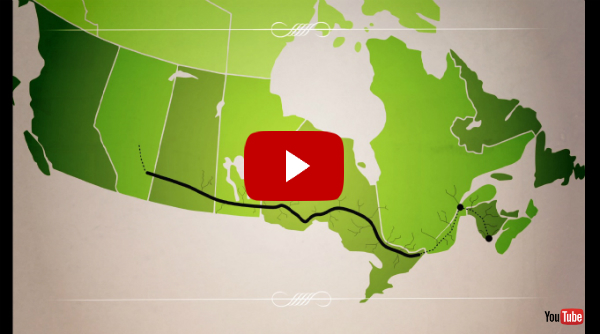TransCanada has spent millions on advertising, desperately trying to convince Canadians that Energy East is about getting oil from Western Canada to eastern Canadians. In reality, evidence shows very little of the oil that could flow through the proposed pipeline would ever be used in our country. As our new video shows, Energy East is an export pipeline.
TransCanada continues to try to convince Canadians that the Energy East project is about supplying Canadian oil to Canadians – and that Eastern Canada will benefit. Many in Atlantic Canada work in the oil patch because of the lack of local opportunities. TransCanada is exploiting the lack of local opportunities by implying that by moving oil through Eastern Canada, some of that oil money will somehow rub off. It won’t.
Our report shows up to 90 per cent of the oil in Energy East would likely be exported unrefined from the East Coast. If built, Energy East won’t supply Canadians with energy, and it won’t deliver many tangible benefits to Eastern Canada.
Here’s why: Energy East could only connect to three oil refineries across its entire route. But, by the time Energy East could be built, these refineries would already be fully supplied with oil from other sources.
None of these refineries are currently setup to process the ultra-heavy bitumen that Energy East is proposed to carry. Plus, oil travelling on Energy East would likely not be cheaper than oil coming from those other sources, providing little incentive for eastern refineries to process much of the oil travelling on Energy East. That’s why a spokesperson for the Valero refinery in Levis, Quebec was quoted saying the company has “no firm interest” in the Energy East project.
With refineries along the route likely full from other sources, the majority of oil from Energy East is expected to be sent onto tankers to be refined outside of Canada, meaning few full-time permanent jobs will be created in Eastern Canada.
Need more proof the pipeline is all about export? TransCanada in its paperwork for the project described “constructing the associated facilities…required to move crude oil from Alberta to Quebec and New Brunswick including marine facilities that enable access to other markets by ship.”
For further evidence that Energy East is an export pipeline, consider the math. With a proposed capacity of 1.1 million barrels per day, Energy East would carry roughly double the amount of oil actually used in all of Eastern Canada. So who is all of that oil for? The project wasn’t designed primarily to supply Canadians.
And if the oil isn’t intended for Canadians, and the project will have little economic benefit in Canada, why should we let TransCanada build it, especially when the risks are so high?
There are substantial risks to Canadians from running a high-pressure oil pipeline across nearly 1,000 waterways. Energy East would threaten drinking water supplies, major lakes, rivers and ocean, and the local economies of whole regions that depend on a healthy ecosystem to thrive. Take for example, the whale watching industry, or the fishing industry in the Bay of Fundy. What would happen to those jobs if there were a pipeline rupture or a tanker spill? And the climate impacts are big. Emissions associated with Energy East would be equivalent to putting 7 million new cars on the road.
Also troubling is TransCanada’s implied appeal to xenophobia in its assertions that Energy East would offset oil coming in from a list of foreign sources. By repeating the same inaccurate talking points, suggesting that 86 per cent of oil imported into Eastern Canada comes from “overseas sources like Saudi Arabia, Nigeria, Venezuela and Algeria,” TransCanada is hoping you haven’t read the business section of the newspaper recently. For over a year now, Canada has been importing more than half its oil from the United States. And last we checked, Canada had imported zero oil from Venezuela since 2014. You can read more on this in our report here.
It’s true there is a shortage of high quality, permanent jobs in many communities across Canada. New strategies and modern investment are needed to bring economic development and jobs. But Energy East would bring neither of those things. Once the construction crews would finish, few permanent jobs would remain. And remember that oil is a volatile commodity. As occurred recently, prices can dip dramatically low and job losses can follow.
While we’re calling for Energy East to be scrapped, we’re also calling for a clean economy strategy, driven by safe, modern renewable energy, which will create new employment opportunities with a future. Around the world, other countries like Germany, Costa Rica, and even China are increasingly powering their economies with safe, modern clean energy. And Canada is at risk of being left behind.
We don’t need to choose between a healthy economy and a healthy environment. We can have both.
TransCanada is looking out for its bottom line, not Canadians. The interests of the oil industry are to build oversized export oil pipelines. But, the best interests of Canadians are served by limiting our dependency on a risky, unsustainable industry, while transitioning our economy to a modern clean, and diverse economy.
In an era where action is desperately needed to cut carbon emissions, Canada has much more to gain pursuing new clean energy than locking ourselves into dependency on oil. Canadians understand this — just two weeks ago 25,000 people marched through Quebec City to say no to risky pipelines and yes to climate action. Now it’s time for our provincial and federal officials to get the message.



